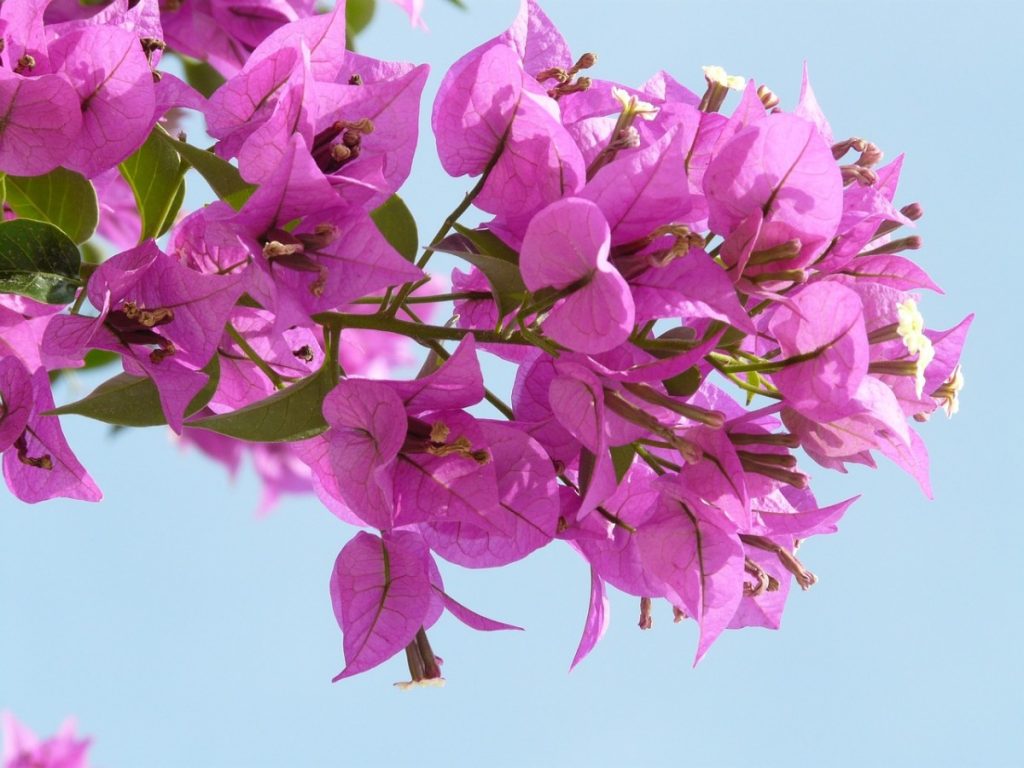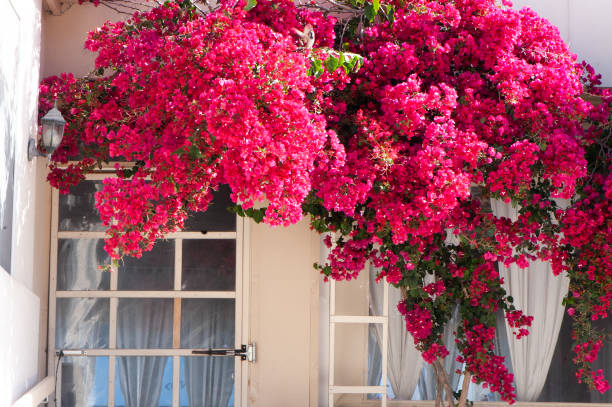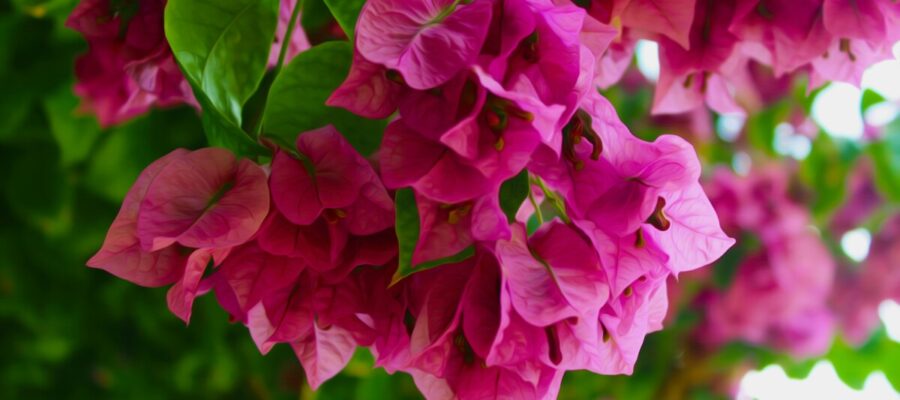Buganvilie are one of the most colorful and exuberant plants that can be found in gardens, balconies and even tropical urban landscapes.
With its vibrant flowers and the ability to grow rapidly and densely, this plant attracts attention wherever it goes.
However, few people know that what we call Buganvília's «flower» is not, in fact, the real flower of the plant.
We explore a little more on this fascinating plant and how to transform any space.
What are Buganvilies?
Buganvília (Bougainvillea) is a native plant in South America, more specifically in Brazil, but nowadays it is located all over the world, especially in hot climatic zones.
The Buganvilies belong to the Nyctaginaceae family and are known for their ability to thrive throughout the year, bringing an explosion of colors to any garden.
Contrary to popular belief, Buganvília flowers are not the color of the bratto that the plant has, but small and discreet flowers in the center of these bracts.
Brattee, which may vary between shades of pink, purple, red, orange, white and even yellowThey are responsible for the vibrant aspect of the plant. This phenomenon is an example of adaptation of nature, in which the plant uses its bracts to attract pollinators such as bees and butterflies.
How to make Buganvília grow
Buganvília is a relatively easy plant to take care of the ideal conditions for their development. Although it can become lush, it is important to know how to grow it correctly so that it grows healthy and lasts for many years.
1. Choice of the place
Buganvilie love the sun and need a good amount of light to thrive correctly.
Therefore, it is essential to plant them in places that receive direct light for several hours of the day. A good advice is to plant in a south or west garden where the sun is more intense.
2. Soil and irrigation
Although Buganvília is resistant and tolerant of different types of soil, it prefers well -drained soils.
Avoid the soils that maintain too much water, since the plant can be susceptible to the rot of the roots. As for irrigation, it is important to water it regularly, but without excess.
In fact, Buganvília adapts better to drought periods than constant humidity.
3. Pruning and maintenance
Because the plant remains healthy and dense, regular pruning is essential. During pruning it is possible to control the size of the plant and also encourage the growth of new branches which in turn generate more flowers.
Pruning should be made at the end of winter or early spring when the plant is not in full flowering.
4. Fertilization
Ferteration is another important practice to maintain Sana Buganvília. During the growth station, use a balanced fertilizer, with lower levels of nitrogen, to avoid excessive growth of the leaves on the flowers.

Variety of buganvilies
There are several species and varieties of Buganvilie, with different colors and characteristics. Among the most popular are:
- Buganvila 'Barbara Karst': One of the best known varieties, with intense red flowers and vigorous growth.
- Buganvila 'Be Higgins': With bracts in shades of pink and lilac, it is one of the most used varieties in landscape.
- Buganvília 'Purple Queen': As the name suggests, it has bright purple flowers, creating an extraordinary effect on the garden.
In addition to these, there are also varieties of white flowers, purple and even multicolors, which allow gardeners and landscapes to create visually stunning landscapes.
Advantages and uses of Buganvilies
Buganvilie are not only beautiful; They can also be useful in many ways. Here are some of the main advantages and uses of this fascinating plant:
1. Landscape
Buganvilie are widely used in the landscape due to their ability to create an explosion of color in any environment. They can be cultivated as shrubs, screws or even vivid fences, offering a vibrant and pleasant aesthetic.
2. Attractive for pollinators
The plant is also excellent for attracting pollinators such as bees, colibrì and butterflies, making it a fantastic addition to the ecological gardens. Your nectar is an excellent power supply for these beings, helping to maintain local biodiversity.
3. Resistance to dry climates
Another advantage of Buganvies is their drought resistance, making them an excellent choice for the regions with very hot and dry summers. Their ability to thrive with low water makes them ideal for the low gardens of water consumption.
They are widely used in landscape projects due to their beauty and versatility.
Special cure for cold climates
Although the Buganvilie are adapted to hot climates, it is possible to cultivate them in colder regions, provided that some special treatments are taken.
During the winter, it is important to protect the plant from the intense cold, covering it with a thermal blanket or take it to the house if it is in a pot.
Keeping the plant in hot or direct sunlight can help prolong its flowering.

Use of buganvilies in landscape projects
Here are some creative ways to take advantage of Buganvilies in their outdoor spaces:
- Pergolas and Capriates: They are perfect for covering pergolas, trusses or similar structures. Its trembling allows colorful flowers to spread throughout the space, creating a fascinating and shaded environment.
- Flower beds and edges: Cry along the beds or as a border in your garden to add a touch of vibrant color. They can serve as a beautiful wall of flowers, delimiting specific areas and bringing life to their spaces.
- Vertical gardens: They can also be grown in vertical gardens. Install appropriate panels or structures and let the plants tremble and create a vertical exhibition of colors and plots.
- Suspended ships and containers: If you have a limited space or you don't have a garden, the Buganvilie can also be grown in suspended vessels or containers. Put them on balconies, terraces or sunny areas to add an outbreak of color to your environment.
- Surrounding and fences: Use them to cover spreads or fences in your garden. In addition to providing privacy, they create a wall of splendid flowers that transform their space into a tropical refuge.
Conclusion
Buganvilie are an excellent option for those who want to give more life and color to their garden. With its vibrant tones and resistance, it easily adapts to different conditions and can be grown in both vessels and large areas.
As long as he is well cared for, Buganvília can be a true masterpiece of the landscape, attracting the attention of those who pass and provide a more natural and cheerful environment.
Credits: Photo Pixabay.com – Video: @Spagnholplants1

How to cook winter radishes?

FLOWER CLOVE-MARITIMA ARMERIA: Cultivation and care

The importance of bees for pollination

The final guide on how to plant, take care and discover the origin of Coleonema

The wisdom of the garden: the influence of popular proverbs on the plantation and the care of natural flowers

Let's discover the rose and its secrets: the May plant

Friar Kiss – Balsamin Family

Amarilis – Learn to take care (Hippeastrum Hybridum)

CHANTRIERI NOC – The bat flower has flowers resemble the bats



